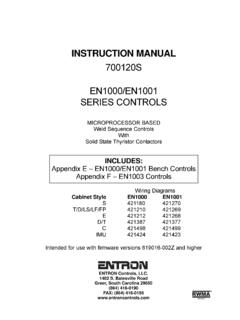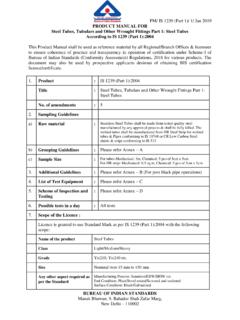Transcription of RESISTANCE WELDING BASICS - Entron Controls
1 Entron Controls , LLC. 700081 CENTRON Controls , S. Batesville Road700081 CGreer, South Carolina 2965004/14(864) 416-0190 FAX: (864) WELDING BASICSWELDING SEQUENCEDEFINITIONSMACHINE SET-UPRULES FOR MAKING GOOD WELDS700081C Entron Controls , PAGEINTENTIONALLYBLANKENTRON Controls , LLC. 700081 CINTRODUCTION TO RESISTANCE WELDINGWhat is RESISTANCE WELDING ? RESISTANCE WELDING is one of many methods of fastening two or more pieces of metal of these methods are listed below in order to illustrate how RESISTANCE WELDING differsfrom the Bolting2. Riveting3. Soldering4. Arc Welding5. RESISTANCE WeldingBolting, riveting, soldering and arc WELDING all require some additional material to be added tothe metal being fastened together. Additionally, bolting and riveting require holes to be madeinto the metal for the rivets or bolts to fit. RESISTANCE WELDING requires neither additional materialor holes in the is a RESISTANCE weld made?The two pieces of metal to be joined are squeezed together by the electrodes on the weldingmachine so they are in good electrical contact.
2 Then electric current is passed through them,heating them until they begin to melt at the spot wherethey are in contact. The molten metal from the two piecesflows together; then the current is turned off and the moltenmetal solidifies, forming a solid metallic connectionbetween the two pieces. The term RESISTANCE WELDING comes from the fact that it is the electrical property ofresistance of the metal being welded that causes heat tobe generated when current flows through THE WELD IS MADEF igure Entron Controls , are the important factors in making a weld?Important to the proper formation of the molten area between the pieces of metal being weldedis the magnitude of current, the length of time it flows, and the force squeezing the parts optimum value of these parameters varies with the type of metal and its thickness. Forcommonly used low- carbon steel 1/16" thick, a typical value of current is 10,000 amps, for atime of 1/4 second, and 600 pounds electrode force.
3 RESISTANCE WELDING schedules are availablethrough the American WELDING Society, RESISTANCE Welder Manufacturers Association, and frommost WELDING machine is adequate current obtained?A current of 10,000 amps is not readily available from any standard electrical outlet. 15 amps isthe maximum current available from common household and office outlets. Even in factorieswhere large amounts of electrical energy is used, 200 amps is typical of the current availablefrom electrical distribution circuits. Therefore, to get the 10,000 amps needed for resistancewelding, some device must be used to step the current up from the relatively low level availablefrom the power device generally used is a transformer. Transformers are usually thought of as steppingvoltage up or down, but current can also be transformed in the same way. A transformer consistsof two coils of wire, called the primary andsecondary, wound around an iron is transferred from primary tosecondary via the magnetic properties of theiron.
4 The factor by which the current orvoltage is stepped up or down is roughlyequal the ratio between the number of turnsof wire in the coils forming the primary andSIMPLIFIED DIAGRAM OF A WELDING TRANSFORMERF igure Controls , LLC. 700081 Csecondary windings of the transformer. In the preceding example, where 10,000 amps wasrequired, a transformer could be made with 100 turns on the primary and 2 turns on the secondary;a turns ratio of 50. A 200 amp current in the primary would then be transformed into 200 x 50,or 10,000 amps in the secondary, enough to do the WELDING is the time controlled?The length of time the WELDING current flows through the two pieces of metal to be welded isalso important. Therefore, the device used to turn the current on and off is a critical part of thesystem. A relay or hand operated switch might be considered as a switching device, but eitherwould be unsuitable because of the relatively slow speed of operation. In the preceding example,the current must be on for only 1/4 second.
5 It is very difficult to turn a switch on and off againin 1/4 second, and even more difficult to do it consistently. Therefore, some electronic devicewith no moving parts should be used. Two such devices are available. The ignitron tube, whichhas been used for many years, is one, and the silicon controlled rectifier (SCR), a more recentdevelopment, is another. Both operate by virtue of the fact that a small electrical signal appliedto the device allows it to turn on in a small fraction of a second and conduct a large amount ofcurrent. Removing the electrical signal allows the device to turn off again. Fast turn-on andturn-off are possible because there are no mechanical moving parts. Ignitron tubes operate onthe principle of ionization of mercury vapor, while silicon controlled rectifiers operate on solid-state semi-conductor principles similar to is the electrode force obtained?The third critical factor in RESISTANCE WELDING is the force squeezing the metal parts together(Electrode Force).
6 This force is necessary to assure good electrical contact between the partsbeing welded, and to hold the parts steady until the molten metal forming the welded joint hastime to solidify. Depending on the size and type of WELDING machine , various methods ofdeveloping the electrode force are used, but the most common is to use compressed air in a1-3700081C Entron Controls , and piston arrangement. The cylinder isrigidly attached to the WELDING machine frame,and the moveable piston is connected to the upperelectrode. Compressed air introduced into thecylinder develops a force on the piston which, inturn, pushes the electrode down against the metalbeing welded. The amount of force applieddepends on the area of the piston and the pressureof the compressed air. In the preceding examplewhere 600 pounds of electrode force was required,a five inch diameter piston would require an airpressure of 30 pounds per square is a RESISTANCE WELDING control?
7 It may be concluded from the preceding paragraphs that it is important to apply the weldingcurrent at the proper time during the operation of the WELDING machine . This is the function ofthe WELDING control; in fact, the purpose of a WELDING control is to coordinate the application ofwelding current with the mechanical motion of the WELDING machine . More specifically, it tellsthe electrodes when to close and when to open, and it tells the WELDING current when to start andwhen to stop. The WELDING control may be thought of as the brains and the machine as the muscle of the overall RESISTANCE WELDING is the WELDING control connected to the WELDING machine ?Since the WELDING control provides control of both WELDING current and machine motion, it mustproduce two control signals one to turn the SCRs or ignitrons on and off (for current control)and one to turn an electrically operated air valve on and off (for machine control). The SCRs orignitrons perform basically a switching function and so are connected in series with the weldingSIMPLIFIED DIAGRAM OFTHE WELD FORCE SYSTEMF igure Controls , LLC.
8 700081 Ctransformer in much the same way any switch is connected in series with its load. Note also thatthey are connected in the primary rather than the secondary circuit of the transformer becausethe current requirements are lower in the DIAGRAM machine AND CONTROL HOOK-UPFigure Entron Controls , OF A TYPICAL PRESS TYPE WELDING MACHINEF igure Controls , LLC. 700081 CWELDING SEQUENCES AND DEFINITIONSF igure 6 explains with line drawings a typical WELDING sequence. The WELDING Process Times at the top describe the WELDING machine operating time intervals, while the Control Times line at the bottom refers to the dial settings on the WELDING control. The following definitionsmay help in understanding this drawing:Squeeze Time is the time interval between the initial application of the electrode force on thework and the first application of current. Note that this is the process definition. The controldefinition is the time interval between sequence initiation and beginning of weld current.
9 Squeezetime is necessary to delay the weld current until electrode force has built up to the desired Time is the time during which WELDING current is applied to the work in making a weld. Itis measured in cycles of line voltage as are all timing functions. One cycle is 1/60 of a second ina 60 Hz power Time is the time during which electrode force is maintained on the work after the lastimpulse of WELDING current ceases. Hold time is necessary to allow the weld nugget to solidifybefore releasing the welded Time is the time during which the electrodes are off the work. The term is only applicablewhere the weld cycle is repetitive (control set on REPEAT ).Weld Current is the current in the WELDING circuit during the making of a weld. The amount ofweld current is controlled by two things: first, the setting of the transformer tap switch determinesthe maximum amount of weld current available; second, the % current control determines the% of the available current to be used for making the weld.
10 Low % current settings are not2-1700081C Entron Controls , recommended. Adjust the tap switch so that proper WELDING current can be obtainedwith the % current set between 70 and 90%. The only time the % current should be set below70% is when the tap switch is on its lowest setting and 70% current is still too Force is the result of air pressure applied to the air piston connected directly to thehead. The actual amount of electrode force depends on the effective air pressure, weight ofhead, and piston diameter. Most welders have electrode force charts on the side of the machine ,tabulating air pressure vs. electrode force. If there is no chart available for the machine , use thefollowing formula:Electrode Force =.78 x D2 x P or x D2/4 x Pwhere: D is the piston diameter in inchesP is the air pressure in pounds per square inchElectrode Force is in poundsThis does not allow for dead weights and friction. It may be necessary, when changing electrodeforce from one value to another greatly different value, to re-adjust the speed control slow an approach wastes time and may require a much longer squeeze time.








